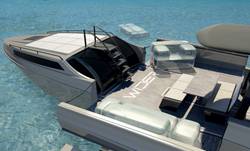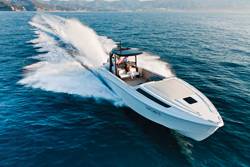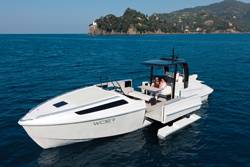



A planning boat that is light, fast and economical, yet has the usable deck area of a boat twice it’s size and the stability of a trimaran! Sounds too good to be true, well that was my initial reaction until I attended the Press launch in Italy of the “transformer” Wider 42.
I call it transformer because that’s what it does. It can plane at speeds over 50 knots and when it stops, by pressing a button, in 12 secs it transforms the cockpit deck into an are twice its size. To ensure stability, two sponsons, one each side slide out from the hull to increase stability. The original and extended working areas are completely flat and a table can be raised from the floor to provide a raised working surface or dinette.
The boat demonstrated is aimed 100 per cent at the recreational market and while still on the drawing board attracted several domestic and international orders.
The concept of the transforming hull is the vision of Italian naval architect Tilli Antonelli , founder and former President of Pershing, one of the Ferretti Group’s most important brands. He left the Group a year ago to launch the new marine company Wider Yachts. They are located in Castelvecchio di Monteporzio (PU), near the Adriatic coast of Italy in one of Pershing’s former facilities used for developing and building yachts in the period from 1990 to 2004: it occupies an area of 10,000m2, (100,000 ft2) of which 4,600m2 (50,000 ft2) is covered.
Several members of Pershing joined Antonelli’s new team including two partners: Paolo Favilla, previously General Manager of Grandi Navi Veloci and CEO of Pershing, and Vincenzo Sulpizi, former Interior Designer, and subsequently Project Manager. All the shipyard’s models are endorsed by the hand of Fulvio De Simoni, the prestigious yacht designer who was with Pershing from the beginning. This skilled team were able to build the first Wider 42ft (12.9 m) from concept to finished boat in an eight month period.
It was Tilli Antonelli who had the idea to think out how to effectively double the cockpit area without (permanently) increasing its length or beam. Pushing a button, it transforms the cockpit size to two times its beam in only 12 seconds. The enlargened area is only permitted to be activated when the boat is at rest, or at manoevring speed below 3 knots. To ensure sufficient stability to carry the extended cockpit width, part of the hull folds downwards and outwards, into the water as sponsons to provide increased buoyancy. In the Wider 42, the boat’s width increases from 3.5 (11' 6'’) to 6.6 m ( 21' 7"). Although the transformation is usually carried out symmetrically, i.e. on both sides, if required, for example if going alongside another vessel or quay, one of the sides can be retracted without affecting the stability of the structure. A sunshade attaches to the Bimini Top to cover the cockpit area completely even in the widened condition.
The Wider mechanism rests onto of the sealed hull eliminating any connection between the interior and exterior of the yacht. The parts of the system are produced in pre-impregnated carbon for lightweight, great strength and prevents corrosion for a reliable lifecycle. The design is such that there are no shafts or rods protruding through hull that could leak or cause flooding of the hull.
As a luxury motor yacht, much attention has been given to its comfort and ease of use. There is a carbon fiber bench in the cockpit that doubles up as a dinette rising up out of the deck on pressing a button. Light and comfortable seating while reducing space when not in use is achieved by the provision of a full set of inflatable cockpit furniture which doubles as floatation objects for bathers. The pilot and copilot seats fold up to reveal a cockpit galley, complete with sink, worktop, teppan-yaki griddle and a 50 ltr (1,8 cubic ft) ice box.
The remarkable appearance and striking design of the Wider 42 also delivers outstanding performance. Three times world offshore powerboat championship winner and race boat designer Mark Wilson supervised the hull design and propulsion specifications. The hull is double stepped providing excellent lift for fast planing and a high top speed with good stability. The construction of the hull and components is extremely light in weight being produced in 70 per cent hybrid carbon textile using the patented Scrimp System of vacuum infusion moulding. The vacuum technique ensures a consolidated bonding of resin with the fibers and closed cell PVC core thereby eliminating opportunities for delamination of the structure. Many other parts are produced in carbon by the alternative prepreg (pre-imprenated) autoclave technique to achieve similar results.
The cockpit deck and other surfaces have the appearance and touch similar to teak, however the material chosen is ESTHEC, a composite which has an environmentally sustainable life cycle, is non-slip, fireproof, virtually indestructible, is stain proof and does not require maintenance.
A large sun bed is located on top of the cabin roof. Inside, the cabin is fully equipped for comfort for over day or overnight use. The galley is well equipped with a 160 lt (5.6 cubic ft)double drawer fridge and freezer with ice maker, sink and ceramic glass hob. An optional microwave oven can be installed in an eye level locker. A rounded sofa with dinette converts into a large bed and there is an optional LED flat screen addition to the standard music centre. The head includes a shower cubicle, washbasin and carbon toilet. The interior decor and layout can be customised according to the owner’s wishes.
At the stern the design incorporates a ramp for convenient launching and retrieval of an inflatable boat up to 3.4m in length, alternatively a jetski. When not in use, the space provides an additional sun deck.
The standard propulsion package is twin turbocharged diesel engines with Arneson ASD #8 surface drives running Rolla six blade, stainless steel propellers. The mounting of the engines is staggered, racing style, so they can be mounted closer together to reduce beam requirement. One power option is twin Yanmar 8LVs of 279 kW (370hp) each, a top speed of 44 kn is achievable with a cruising speed of 40 kn. A higher power alternative is twin Cummins QSB 5.9 of 352 kW (480hp) giving a top speed of 53 kn and cruising speed of 46 kn. The efficiency of the hull is proven by the low fuel consumption of only 100 l/h (26 US galls/h) for both Cummins engines. The standard 1,000 ltr (264 US galls) fuel tank, therefore gives a cruising radius of 400 nautical miles or a passage distance of approximately 900 nautical miles, allowing for reserves. These speeds are estimates with the boat one third fully laden. A bow thruster is provided to improve manoeuverability.
The propulsion, instrumentation and navigation equipment is all connected to a high speed CAN-bus network designed by Naviop that ensures full integration and control of the different individual devices. Instead of the usual bank of switches and instruments on a dashboard, all the command and control functions are centralised in a Formula1 style, multi-functional steering wheel with built-in multi-view touch screen display. It allows complete overview of the operating parameters as well as commanding the propulsion functions such as throttle, trim etc. In addition there is a conventional helm station with throttle controls and 12 inch touchscreen display for radar, navigation charts and echo sounder.
To date, orders for seven boats from customers in USA, South America and Europe have been received based only on the drawings and specifications and before the demonstrator was completed. The unit cost is EUR 780,000 (US $ 1,16M) and includes a very high specification of equipment and accessories. The number of options is limited due to the high initial specification. Now that production has already started on the 42 footer, plans for a smaller Wider model measuring around 35 feet (10.7m) and a larger one of around 50 feet (15.2m) will follow, both of which will maintain the Wider philosophy of widening cockpits.
The main focus of Wider Yachts is on recreational applications, however they recognise that there is potential using their patented technology for numerous commercial / workboat applications where a wider more stable platform would attract interest for e.g. surveying. There could also be security / naval applications for vessels equipped with this expansion system. In view of Wider Yachts’ many orders for recreational boats, and their commitment to that market, they believe that demand for other applications may be best achieved through a licensing arrangement with other yards, specialised in commercial or naval markets .
Tilli Antonelli President
Born in Russi, province of Ravenna, Italy, in 1955, Tilli’s passion for the sea has been clear since his adolescence when he began to take part in regattas, participating in the most prestigious competitions on the international scene. In the 70s, Tilli assisted Raoul Gardini on board his fleet of yachts, as well as with the famous first of the five Moro di Venezia. It was only in the 80s, however, that he began his entrepreneurial career when, along with a couple of friends, he had the great insight which would change his life: to build motorboats. The first boat built by his young company Cantieri Navali dell’Adriatico – later to become Pershing - was launched in 1981. Four years later, in 1985, the first Pershing 45’ was built, created by yacht designer Fulvio De Simoni. During the following years, Pershing asserted itself as one of the leading companies of Italian-made yachts in the sector of open fibreglass models, thanks to the intuition of its founder, who established new style elements and trends which would influence the international nautical market. In the 90s Pershing joined the Ferretti Group finding new drive by investing in research and development, and Antonelli maintained his role of company President. In 2004, Antonelli also began dealing with management of the Itama brand, taking on the role of President, which he maintained until 2009. On 3rd March 2010, Tilli Antonelli left the management of Pershing S.p.A. to launch a new project: Wider.
Fulvio De Simoni
Yacht designer of international fame, De Simoni has had a close working relationship with Tilli Antonelli since 1985, the year in which he contributed to outlining the identity of the first Pershing yacht. Born in La Spezia, at the age of 14 he already had his own boat, proof of an innate passion for the sea, and knew all its secrets, as well as the needs and requirements of life on board, the foundation for each and every one of his creations. In 1970, he moved to Milan and began his career, devoting himself to design work in the field of sailboats. In 1972, he began working as a designer for Alberto Mercati’s studio; in 1977 he founded Yankee Delta with Massimo Gregori; since 1983, he has been the owner of Italprojects, which endorses projects with high technological content in the naval field. In 1985, he began his lucky alliance with Antonelli, which continues today with the new challenge of Wider. During a career of over 30 years, De Simoni has designed over 2500 for the biggest names in the sector: Mochi Craft, Raffaelli, Gianetti, Antago Yacht, Abacus, Evo Marine, Pershing, Ilver, Ars Monaco, Inace Brasile, Gallart e Rodman Spagna, Trojan Usa, Tarpo Brasile and Simmonea Francia.
(As published in the September 2011 edition of Maritime Reporter & Engineering News - www.marinelink.com)


